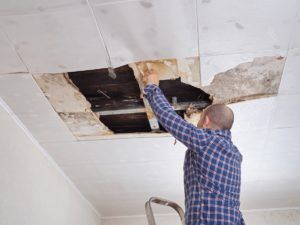How Do I Know if I Have Rotted Roof Decking?
Published on Tuesday March 20, 2018What is Roof Decking?
Roof decking, also called sheathing, is the foundation of your roofing system that connects the roof to your house. It’s the base that lays on top of the structural trusses—the “bones” of your attic—to cover the rafters and support the weight of the roofing shingles.
Although you can’t see it, roof decking is very important to the structure of your home. And if a home’s roof decking is rotting and unable to support the weight of the roof, it can cause some very serious structural issues.
What is the Best Option for Roof Decking?
Most roof decking is made from plywood or a plywood composite known as Oriented Strand Board (OSB). OSB is composed of intertwining wood strands bonded together by a waterproof resin and is a popular option due to its low price point. Plywood, while a bit more expensive than OSB, is much denser and provides greater protection against moisture.
What Causes Rotted Roof Decking?
Water is your roof’s number one enemy. Since roof decking is made from wood and wood composites, it is particularly susceptible to rotting and water damage when continuously exposed to sustained or excess moisture.
Water seeps into your roofing system in many different ways. Old and worn out roofing shingles, overflowing roof gutters or spouts, torn flashing around chimneys, ice dams or snow accumulation during the winter season, excessive humidity and rising heat in the attic, and inadequate roof ventilation can all allow water and moisture to slowly make its way into your roofing system and lead to rotted roof decking.
“Not repairing a leak as soon as you notice it can lead to mold, damage to the structure of your home, water damage, and even fire if water comes in contact with electrical wiring,” Carlos de León, vice president of the León Group, told Realtor.com.

What are the Signs of Rotted Roof Decking?
There are many signs of rotted roof decking:
- Roof leaks
- Wet spots on the ceiling
- Stains on interior walls
- Peeling wallpaper
- Water stains on rafters
- Mold and mildew in your attic
- Sagging ceiling or roofline
One of the most common signs that a roof’s decking is damaged is a roof leak.
Water leakage can lead to ceiling spots or leaks, stains on interior walls, cracked paint, or peeling wallpaper. A quick inspection of the attic might uncover dark water stains on the rafters or in the insulation, or even light passing through holes in the roof. If left undetected, mold and mildew will develop in the walls, ceilings and insulation.
A sagging ceiling or roofline is another clue that there are major problems with a roof’s decking and the roofing structure. Soaked or waterlogged decking can warp, which can lead to a bowed or wavy roofline and ceiling.
Since your roof is consistently exposed to various weather conditions, the National Roofing Contractors Association recommends that you have your roof inspected twice a year—once in the fall, after hot weather has subsided, and once in the spring, after the danger of ice and snow is behind you. You should also have your roof inspected after a big storm, hurricane, or other potentially damaging weather event.
Should Roof Decking be Repaired or Replaced?
Thinking about trying to extend your roof’s shelf life by doing a quick patch job? Think again.
When it comes to rot, roof deck repair isn’t an option — It must be fully replaced. The longer you go without replacing roof decking that’s been damaged, the more problems it can create, leading to costly repairs and more mold and mildew.
Long Roofing uses the Integrity Roof System, which includes Diamond Deck high performance underlayment to work with your shingles to protect your roof deck. In addition, products like WinterGuard® waterproof underlayment provide an extra layer of protection at vulnerable places like the edges and seams of the roofing system where water is most likely to penetrate.
When installed as part of an Integrity Roof System, these products create effective ice and water barriers. Long Roofing’s SureStart PLUS® roofing warranty, which can cover your roof up to 50 years, provides another level of comfort and security.
While replacing a roof is an expensive undertaking, it’s certainly less costly in the long run than replacing stained drywall, waterlogged framing and joists, or water-damaged electrical systems.
Do you Have Rotted Roof Decking?
It may be time to replace your roof. When you need a new roof, contact Long Roofing to request an estimate online.
Interested in Long Home Products?
See our special offers now.









